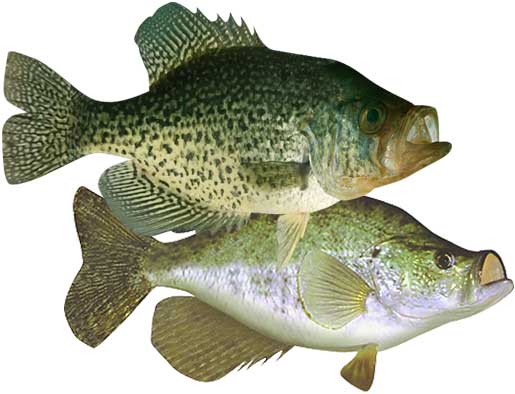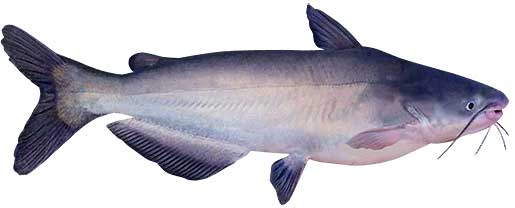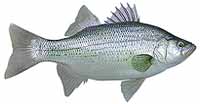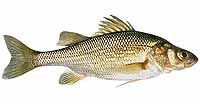Fishing Report For Buggs Island Reservoir (Kerr Lake)
By Rick Seaman
Last updated on .
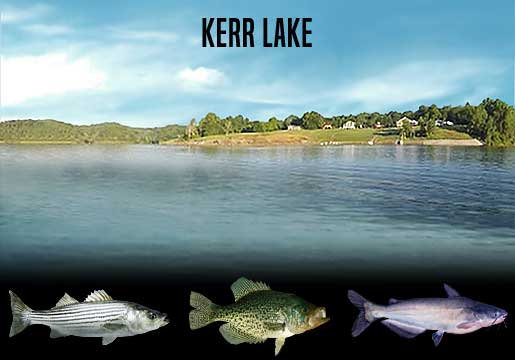
Fishing Reports
Popular Fish Species Kerr Lake, NC
Striped Bass
Current Report: Good To Very Good
Prolific schools of shad in Kerr lake are the reason stripers are growing fast. The bait is everywhere, so striped bass don't have to go far for a meal.
FALL. Now that the shallows are cooling off, stripers have moved shallow following the bait. Striper anglers report plenty of fish in the 5 lb to 10 lb range, and an occasional fish over 15 pounds. Early in the day wipers chase bait to the surface and feed aggressively, making this an excellent time for topwater action. Stripers here populate the Goat Island-Clarksville Bridge corridor, in the Nutbush arm, in the Island Creek arm, and the mouths of the Roanoke and Dan River arms. They follow schools of bait, which are hanging out in 10 to 30 feet of water. Look for shallow water nearby deeper river channels, and fish them thoroughly. Most any lure that resembles shad will catch striped bass at this time of year. Late Fall will find most of the stripers in 30 to 60 feet of water.
WINTER. In Winter, stripers again hang out in deeper water and feed close to the bottom, often as deep as 80 feet. Warm, sunny afternoons occasionally draw stripers shallower, to around 20 or 40 feet deep as they feed on roaming schools of threadfin shad and gizzard shad. In the cold months, schools of stripers can be found throughout the main lake basin, around deep structure. The lower end near Kerr Dam, on mid-lake islands and points, stripers are also commonly found in 40 to 80 feet of water. Locate schools of bait, then look for stripers close by. Fish finders, and forward facing sonar, are a big help in locating these roaming schools. Nice stripers are caught while drift fishing with live bait or cut bait. Spoons, blade baits, and heavy hair jigs are also effective this time of year. Due to the stripers slower metabolism this time of year, anglers are triggering more strikes by working baits more slowly.
SPRING. Water temperatures are return to the mid 60's, and that's ideal for the stripers to spawn. In Spring, work the upper end of the lake, and the backs of coves, where there is inflowing water. If they spawn, this is where they will lay eggs in the moving water. They also move into transition zones on the main lake, in 5 to 25 feet of water, feeding on baitfish which are moving toward the shallows. Later in Spring, expect to locate them on mid-depth ledges, flats or points in 30 to 60 feet of water.
SUMMER. Summer months are the ideal time to chase striped bass here. These stripers hang out in deeper water during the heat of the day, 50 to 100 feet deep, early in the season. Much of the time they are holding over deeper, open water. Morning often draws the stripers shallower, so look for them around the 15 to 30-foot range as they feed on roaming schools of baitfish. Being successful at fishing for stripers in Summer is a matter of locating schools of bait, and the wolf packs of stripers are likely to be nearby. Fish finders, and sonar electronics, are a big help in locating these roaming schools. Nice stripers are being caught while trolling or drift fishing. Spoons, blade baits, crankbaits, live bait and cut bait are all effective here.
Black & White Crappie
Current Report: Good To Very Good
Crappie fishing at Kerr Lake continues to be among the best in the area.
FALL. Baitfish, which have moved into shallow flats, coves and bays, have drawn crappie into these areas. Decent crappie are being caught while feeding heavily, in preparation for the cold Winter. Anglers report that 8 to 20 feet of water is where most bites are coming. Minnows, hair jigs, and crappie jigs, are good options during this feeding marathon. Late fall starts the migration deeper, toward winter holding areas, for both crappie and baitfish. Bluestone Creek, Buffalo Creek, Grassy Creek, and Butcher Creek are all popular areas in Fall. Small flutter spoons, fished in 15 to 25 feet of water, are a good option during this transition. Good results are coming around points, creek channels, and brush piles.
WINTER. Once the shallows start cooling rapidly, crappie will migrate to deeper holding areas, mostly off shore. At this time they are typically caught using a very slow presentation, in 12 to 30 feet of water. Most are caught around deep brush piles, creek channel bends, submerged timber, and main-lake structure. If they are suspending in open water, they often relate to some cover, or structure change, directly below them. During warming trends, especially warm afternoons, they are drawn into 8 to 15 feet of water to feed.
SPRING. In early Spring, crappie begin staging in 3 to 12 feet of water, just outside spawning bays and shallow flats. Spring is prime time to be on the water, as crappie have moved shallow to spawn. At that time, they are typically caught in 2 to 8 feet of water. Vegetation, docks, brush and wood are where most anglers catch crappie using small crappie jigs or live minnows. After the spawn, crappie typically move outside the spawning area and hold on cover close by, in 8 to 20 feet of water. Once they move deep, anglers report success using fish finders and forward facing sonar to locate schools of crappie, which tend to stack vertically around cover. Light tackle, with 4 lb to 8 lb line, is a popular choice. Later in Spring, focus on shallower flats around 5 to 15 feet deep.
SUMMER. Water temperatures get quite warm, and crappie fishing is usually pretty good. They feed in 6 to 12 feet of water early and late in the day, until the hot Summer sun causes them to retreat to depths of 10 to 30 feet. Also, a few have embedded in the shade of slightly shallower vegetation. This is a good time to focus around brush piles, standing timber, deep lay downs, bridge pilings and deeper docks. Anglers are also locating schools of crappie hanging over deep structure and around creek channel edges, using fish-finder electronics.
Blue Catfish

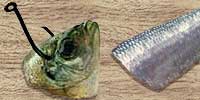
Current Report: Very Good To Excellent
Live bait is a good way to catch big blue catfish in Kerr Lake. Check with the North Carolina Wildlife Dept for regulations on live bait.
FALL. Fall is one of the better times of year for catching channel catfish. Locals also report plenty of big blues being caught on cut bait. The lake record is over 140 pounds. Early in Fall they cruise the shallows, around 10 to 25 feet of water, in search of food. Later, in the season they migrate away from the shallows and current, to moderately deeper holes in the main body of the lake, around 20 to 40 feet deep. They remain in these areas and feed aggressively in preparation for Winter.
WINTER. In Winter, focus on deep holes, in 20 to 60 feet deep, where blue catfish wait through the cold water season. Many of these big blues hold in the river channel between Clarksville and Kerr Dam. They are less aggressive now, but slow drifting, or dead sticking baits, can still trigger bites. Cut bait, or live bait taken from this lake are the top bait choice. Use slip sinkers, 3-way rigs, or Carolina rigs with enough weight to keep the bait bumping bottom as you drift or slow troll.
SPRING. Spring begins the aggressive feeding in preparation for winter. Blues at this time are being caught 5 to 30 feet deep around creek mouths, back arms, in bays, on flats where baitfish school, as well as on shallow ledges. Cut bait is the ideal bait this time of year.
SUMMER. Early Summer is post-spawn season for big blue catfish. They follow big schools of baitfish, around 30 feet deep, and feed heartily. Live shad is the preferred bait at night, while cut bait is catching nice blues during the day. Stay around channel edges and fish areas that have concentrations of bait. Once Summer weather has warmed lake water above the 70's, blue catfish move closer to the main lake, to deeper feeding areas, still preferring to remain in current when available. Most will find holes up to 80 feet deep. Blues, including some of the bigger ones, are now being caught while slow trolling, or drifting ledges, adjacent to river channels, or within the channel along the edges. The lake record here is over 100 pounds, and big blues, 25 to 70 pounds, are regularly caught. Anglers fishing from the bank are catching a few fish, but boats are the preferred approach. Late Summer, if the water temperature rises above the high 70's, they become less active, and fishing can slow down.
Fishing Video
Fish species to fish for...
Guide to fishing for largemouth bass, smallmouth bass, channel catfish, flathead catfish, blue catfish, black crappie, white bass, white perch and striped bass at Kerr Lake in North Carolina.
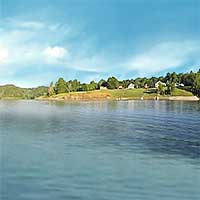 Kerr Lake is a 50,000-acre reservoir with 850 miles of shoreline, and it is loaded with fish. Bass, stripers, crappie, catfish, perch and white bass thrive here in good numbers, and size. To support these species, the reservoir has very healthy populations of bait fish.
Kerr Lake is a 50,000-acre reservoir with 850 miles of shoreline, and it is loaded with fish. Bass, stripers, crappie, catfish, perch and white bass thrive here in good numbers, and size. To support these species, the reservoir has very healthy populations of bait fish.
Primary fish species to catch
Click images for fishing tips and details about each species.
Today's Weather & Forecast
Fishing Boat Rentals
Click here for fishing boat rentals.
Marinas
Click here for marinas.
Public Boat Launch Ramps & Landings
Click here for boat ramps.
Fishing License
Click here for a North Carolina Fishing License.
Map - Fishing & Access
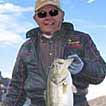 Rick Seaman is a fishing enthusiast with over five decades of fishing experience, a retired tournament fisherman, author of numerous published articles on fishing, and co-author of the book "Bass Fishing - It's not WHAT you throw, It's WHERE you throw it".
Rick Seaman is a fishing enthusiast with over five decades of fishing experience, a retired tournament fisherman, author of numerous published articles on fishing, and co-author of the book "Bass Fishing - It's not WHAT you throw, It's WHERE you throw it".
 Contact Information
Contact Information
Steele Creek Marina & Campground
1603 Townsville Landing Road
Henderson, NC 27536
252 492-1426
Fishing lakes in each state
110625
Kerr Lake, North Carolina Report
NORTH CAROLINA


Striper, sunfish and bass fishing in northern NC.








